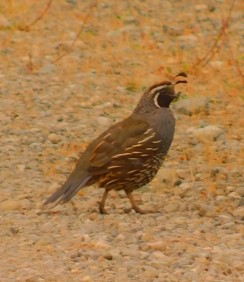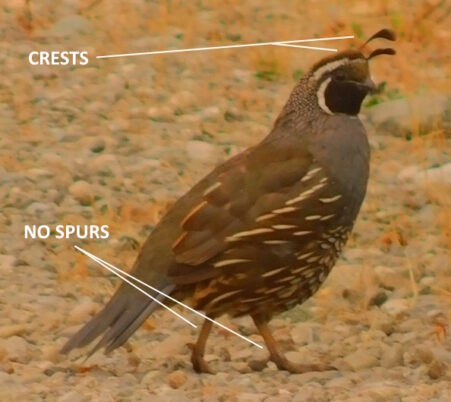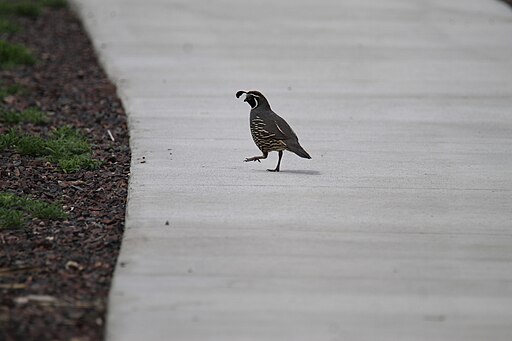CPTC’s Valley Quail
by Marcia Wilson

Down in the Valley
California Quail, also known as Valley Quail, are elusive natives of Pierce County. The late instructor Andy Fritz recorded them several times on his field trips involving Clover Park Technical College. Dr. Fritz did not provide precise details on the location of these little birds, but that is understandable: birds, unlike plants, tend to move around. Reports were exceedingly rare, but on campus their calls were reported in the shrubbery around Building 11. In Western Washington they are found in the open grasslands and healthy oak savannahs. The college owns one of the largest white oak groves in South Puget Sound so the presence of California Quail was always a statistic probability.
California Quail were reaffirmed by CPTC volunteers on the 2024 Grebe Survey last September, during the break between terms. The survey began at the headwaters of Flett Creek and ended at the CPTC border. Early that morning the bank-spotters went to the headwaters. While waiting for the marsh team to catch up, the lead birdwatcher, Cherie St. Ours, made a speech on her aggravating years spent in fruitless searching for the quail.
With impeccable timing, a mature male California quail sauntered out from under a clump of blackberry canes! A second soon followed.
California, callipepla, and conniptions

The Latin name for the quail is Callipepla california, which breaks down to “crest-headed quail from California”. The callipepla are their own genus unrelated to the quail of Europe and Asia, even though they may look similar to each other. The quail native to the American continents also behave differently: they would prefer to run from danger before they start to fly. As a result, they have much stronger and thicker legs than their European counterparts. They also lack the spurs common to European quail.
Look for quail early in the morning when they are more likely to be hunting for food. Before they head out, they will load up on grit to put in their crops. Grit is bits of sand and rock and the friction of this breaks open the hard matter of seeds and nuts. Unpaved roads such as the one along Flett Creek were a perfect example.
Topnotch topknots
California quail have jaunty little feathers bobbing over their heads like little black commas. Called the topknot, it was assumed for years that it was a trait for attracting females. It was later proven that female quail “couldn’t care less” about the topknots on their male’s heads. On the other hand, males care very much about their topknots, and this matters in their social standing. Quail will form large groups, as many as 50-100 birds, called coveys. Coveys are highly interactive and share nests for egg-laying and even raise everyone’s chicks together–covey means “hatching.” But, they are also aggressive and push each other around when the territory isn’t ideal. A male who “struts his stuff” is easily understood by his peers as a Very Important Bird.
Incredible journeys
The quail’s range follows Puget Sound up into Canada. This is partially because of their comfort around humans and skill at going wild. They can adapt to thirsty areas with little to no water, and thrive in cold or warm regions. They are rather easy to transport: quail eggs will “keep” longer than chicken eggs, and egg transport might have expedited their export to in Chile and Argentina in the middle of the 19th-century. Their native range was relatively small, but no more. They can now be found throughout the world and the current population is estimated at over five billion strong.
Presuming, of course, they can be found. As Cherie St. Ours demonstrated, knowing the quail are here is very different from confirming their presence in person. Quail are comfortable with around humans but have no attachment to them. They will go feral and escape at the slightest chance.
Awesome ecology
They are unusual in that their diet is around 75% plant-based, and while they will gorge on the waste seeds and grains of farmland, they like foods that humans avoid such as the berries off poison oak or snowberries. The younger ones are aggressive hunters of crop-damaging snails, slugs, caterpillars, maggots, and grasshoppers. These quail are drought-tolerant and get most of their necessary moisture out of their food.
Quail cost less to farm than chickens, and have a better feed-to-gain ratio. The eggs are highly nutritious. Small-scale farmers know quail farms produce less waste than chicken farming and have a softer environmental footprint. Since the female birds “egg dump”–lay the eggs of different hens in the same nest–egg collection is simple. California Quail are the most popular of the quail in Washington State, valued as a table meat. This meat is excellent, a treat for the table from the rural farm to the highest-priced restaurant.
“In many states, eating the state bird will earn you a $15,000 fine — or six months in prison. Not so in California. California’s state bird is the California quail. They’re also great deep fried. How do I know? Because I ate the California state bird. And it was yummy.”–Thomas Smith, the Bold Italic. I Ate the California State Bird, and It Was Yummy.
